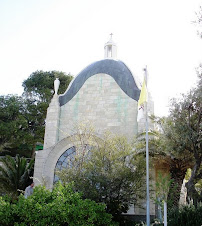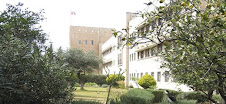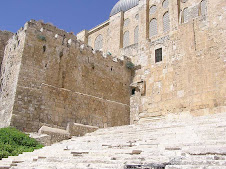7-00 seemed an early start. But it was worth it!
We said farewell to Tantur and made our way by bus out of Jerusalem to the North West, making for Mount Carmel.
We hadn't been going more than ten minutes when Dr Henry Carse, director of special programmes at St George's college began to describe the countryside we were going for.
Many years ago I fell in love with the deserted mediaeval villages of Leicestershire, thanks to the inspirational work of W.G.Hodgkins in
The Making of the English Landscape. He pioneered a way to study history by reading the landscape alongside reading the text of historical documents. Henry Carse had a wonderful ability to do just that, reading the landscape of the Holy Land alongside the text of the Bible and other contemporary writings, especially Josephus, in such a way as to bring the history, the sociology, the politics and the theology of the Bible in a new and refreshing way.
This was what caught my imagination so much on Wednesday.
Reading the LandscapeAs we began to drop down from Jerusalem at 2,600 feet through the limestone mountain ridge that runs the length of the Holy Land, towards the maritime plain, we first went through extensive afforestation. I was sitting with Prem, a Roman Catholic Chaplain at Warwick University, who comes from Sri Lanka. He was spotting features similar to the landscape in Sri Lanka. Initially, the trees were quite stunted and low. The terrain was very rocky. Through the gaps between the trees you could make out the characteristic terracing of the age-old Palestinian agriculture.
We learned that the trees now covered what at one time had been the rich agricultural land that until 60 years ago had provided Jerusalem with its food and its produce. Rich is not quite the right word! It was land that was tough to work. But with hard work it had been productive. And it was the land that had fed the city of Jerusalem in Jesus' day as well.
But the villages had been cleared, the land covered with forestation.
As we dropped lower, not only did the vegetation become fuller but the soil too became much richer. We were now into the state of Israel, within the borders defined back in 1948 by the United Nations. We would be remaining within Israel's borders for the remainder of our stay.
We stopped for coffee and the atmosphere seemed already different, more relaxed. Away from the disputed city of Jerusalem, away from the occupied Palestinian territories.
Descending to the maritime plain the agricultuarl land was clearly very productive, the coastal strip occupied by major industrial cities.
Visiting the Carmelite Chapel of the Muhraqa ('Burning')We headed towards Mount Carmel: hold the thumb of your right hand out and that's like the fairly low, Mountain that juts out into the sea towards the North of the coastal plain.
We ascended the mountain, and went up on to the rooftop of the Carmelitye Chapel of the Muhraqa, the 'Burning'.
The views were breath-taking.
We could look down to the South along the coastal plain. Round a little to the South East and we were looking down the Jezreel valley. This was the route of the Via Maris, a major trade route in the ancient world.
I have always thought of Jerusalem as the great capital and therefore on a major thoroughfare, and of Galilee as the quiet hills where Jesus could retreat peacefully.
Not a bit of it.
In fact Jerusalem and Bethlehem and the neighbouring villages are in the South on a Mountain top. They have immense religious significance. They are a stronghold in the mountains. They are a tinder box for potential conflict. They were in Jesus' day. But they are not on a major thoroughfare.
Looking down on to the world of JesusThe via maris was the route taken by invading Greeks under Alexander the Great, and by the Romans up the Jezreel Valley between Mount Carmel and the hill top town of Nazareth, through a pass we would see later, through Capernaum and on towards Syria, via Caesarea Philippi.
This was where the great ancient trade routes passed.
This was where the Romans were building their major capital in Sepphoris at the time of Jesus's birth and childhood. It was further to the NOrth East that they transferred their capital to Caesarea Philippi.
It all made sense!
That made the Galilee that Jesus was growing up in a massively significant, busy, kind of place. Where Rome and the Jewish people came into conflict. The common language of the Roman Empire would have been spoken by those living there: Greek. Jesus would have read the Hebrew of the Hebrew scriptures. He might well have spoken Aramaic, or a kind of proto Mishnaic Hebrew, that some suggest was common at the day.
He might have gone to the theatre in nearby Sepphoris. He would have been in the thick of the tensions with Rome. Thirty years before his time there had been a revolt in Galileel. There would be another thirty years later.
There were 'zealots' among his followers.
Henry had spent some time on the bus explaining the tremendously volatile mix of groups vying with each other at the time.
Among the Jewish people there were tensions.
He identified four main groups.
The Zealots were those who sought rebellion against Rome.
The Essenes were those who retreated to the monastic life of the Dead Sea and sought a deep spirituality.
Then there were the Pharisees and Sadducees, quite wrongly lumped together in our thinking especially as the Bible stories are re-told.
The two sets of people believed quite different things. The Sadducees didn't accept resurrection, confined the Hebrew Scriptures to the Torah, and were linked with the ruling aristroccary, the High Priesthood, that worked along with the Romans in Jerusalem.
The pharisees, on the other hand, were thinkers and teachers who accepted resurrection, drew on a wider body of Hebrew Scriptures and were upright in many ways. We misread the text of the Gospels when we dismiss them all as hypocrites. They were learned teachers, highly respected, not least by Jesus.
That was something we would come back to later when in the Synagogue at Capernaum.
Returning to that roof top scene as we looked down to the foot of Mount Carmel looking East South East there were two valleys, the second of which was the sight of many ancient battles, and the site of the ultimate battle in Jewish and Christian apocalyptic writing, the valley of (?) Armaggedo.
Looking to the West we could make out hills again. Moving round, the rounded hill in the distance was Mount Tabor, associated by some traditions as the Mount of Transfiguration. Henry suggested the geography didn't work. More likely would be Mount Hermon, the snow-clad mountain standing as the source of the three tributaries that fed into the River Jordan, not far from Caesarea Philippi.. Next we could see the hills of Galilee. And one of the most prominent on the other side of the Jezreel Valley was Nazareth.
I had never realised what a prominent position Nazareth was in. With the naked eye we could make out the outline of a church on top of the hill. The town Jesus grew up in was in a prominent position overlooking a major trade route, just four miles from the Roman capital of Sepphoris, complete with its baths, its forum its theatre and its Roman way of life! This was straightaway a very different place from the sleepy backwater in the hills of my imagination.
Henry was reading the landscape for us in the most exciting of ways, not least as he brought it alive linking it with the text.
Prophet in Crisis - On Mount Carmel with Elijah, then and nowWe came down from the roof top, passed a statue of the triumphant Elijah. And I felt uneasy. Four Israeli soldiers were standing beside it. The slaying of the prophets of Ba'al is one of those stories in the Old Testament I used to read with glee in children's stories, but now find much more difficult.
They have in my mind to be put alongside Jesus and all he had to say in the sermon on the mount.
They also have to be read in the full text of the Scripture, suggested Henry.
So it was we settled down under the trees overlooking the Via Maris and the Jezreel Valley and Janet Tollington and I read practically all of I Kings 18 and 19. All but the bits about Obadiah.
They tell of the crisis Elijah faced as he confronted the prophets of Ba'al. It was a time of famine in the land. The prophets of that other god had been unable to bring rain. Elijah challenged them and turned to his God. With sacrifice, the waters come. The prophets are slain.
But as the story unfolds, Elijah does not feel triumphant. Instead he is troubled and in a vision is transported to the far south to Mount Horeb, and there at the mouth of the cave the voice of the Lord is heard not in the wind, the storm, the earthquake or the fire, but the in the sound of sheer silence.
Even then his problem is not resolved. The crisis continues. New kings are to be anointed, but they too will need a prophet to hold them to account. And so the mantle will pass from Elijah to Elisha.
Any re-telling doesn't do justice to the story. We read it in full.
And then we had to answer two quesetions. First we went round with views of what was going on in the text. What was the crisis for Elijah? It was fascinating to see the different angles to the story that began to emerge.
Then we were asked, what was the crisis for us as we read the story.
Then it was, its message of a prophetic voice holding the King to account began to take off.
Not least because it was difficult to hear.
Not just because we were in the open air. But because the main airstrips of the Israeli air force are on the coastal plain. And this was the second day of the biggest military exercise Israel has held for years. The fighter jets were flying overhead every few minutes. Often we would have to stop until the noise no longer drowned out the word we were sharing.
How we longed for 'the sound of sheer silence'.
This was powerful stuff.
What had it to do with our Journey in the footsteps of Jesus?
Everything.
Elijah and Jesus
At Caesarea Philippi, the disciples when asked suggested Jesus was another prophet, maybe Elijah? There on the Mount of Tranfiguration Jesus was seen in all his glory alongside Moses and Elijah.
So often we tell the story of Peter's confession of faith at Caesarea Philippi as if they had got it wrong.
Read again, there on Mount Carmel, in full view of anyone living in Nazareth and you cannot help but realise that they had got it right. Jesus had come very much as a prophet. And much more!
The last of our Biblical modules Janet and I had written brought together in a single module, the Gospels and the Prophets. We had begun at Caesarea Philippi. As our next module brings together the Law and the Letters I am prompted to begin in 2 Peter with that account of the mount of transfiguration.
This was powerful, exciting stuff.
Our visit to Mount Carmel over, we dropped down into the Jezreel valley, and made our way by bus through Cana of Galilee to the town of Nazareth now 12,500 strong.
Nazareth: Annunciation and ResponseIt was time for lunch. We ate our packed lunches on the terrace of a restaurant owned by a friend of Henry and enjoyed Arabic coffee. Then it was on to the Orthodox Church dedicated to the annunciation to Mary. Built over a spring going back to the first century, and the source of water for teh village, it highlighted a difference between the local Catholic tradition that has the angel Gabriel appearing to Mary in a house, and the Orthodox tradition that has the Angel appearing to Mary on her way to or at the well.
It was moving to link incarnation with the living water we could hear running through the church. INdeed, this ancient church was oriented in two directions. One was the traditional one which Fr Ian explained to us was in three parts. The back represented the Old Covenant, the middle where everyone sat, surrounded by wonderful pictures of saints, represetnted the company of believers, past present and future joining together in worship, and the front, the altar area, behind the Iconostatis representing the kingdom of heaven. The other axis led from the door to the spring, forming a cross.
Most moving to hear Fr Ian's explanation, to see the Icon to Mary at the spring, and to reflect on the link between this tradition and the rich temple worship we had been exploring in Jerusalem.
Walking through the town, there was no house of Jesus to see, no carpenter's workshop. I discovered later there is a museum area that has reconstructed life in Jesus' day complete with carpenter's workshop. That would appeal lto some.
With my love of those deserted mediaeval villages of Leicestershire, where so little can be seen by the untrained eye, I was very much drawn to Henry's itinerary. If you want to see a worker's house involved in the building trade as Joseph, the tekton, would have been, quite possibly in nearby Sepphoris, go to the Roman Museum in Verulamium where they have excavated one and reconstructed the workshop in the museum complete with tools.
In Nazareth we were seeing something different. We could see the 'busyness' of this place overlooking the Jezreel Valley and Mount Carmel to the West. We had a sense of the world Jesus grew up in. Quite a different world from the one of my imagination.
Arbel Cliffs: Rebels and Reconcilers in GalileeThen it was on to the cliffs of Arbel and our first sight of the Sea of Galilee.
It took the breath away!
It was so small, and yet so beautiful.
The high limestone crags were the place of massive fighting not long after the time of Jesus. At our feet the small town of Magdala, home of Mary Magdalene. Small it may have been. But this was where the Via Maris came through its mountain pass and headed past the Sea of Galilee on through Capernaum and North West to Syria.
Br John spotted eagles soaring in the heights.
It was good just to stand and gaze.
One thing you couldn't miss. The cliffs and mountains we we were on stretched to the South. East of us, at our feet the Jordan River came into the Sea of Galilee and then flowed out to the South and on towards the South.
This side of the Sea of Galilee between the crags we were on, and Capernaum were gently rolling hills, rich with corn. They were volcanic, basalt rock that had spewed out of the ground with great volcanic activity. Some of the volcanoes in the distance were pointed out to us. The other side of the Sea of Galilee, quite different cliffs plunged down to the Sea. These were the Golan Heights. The border with Syria, now occupied by Israel.
The sheer geography was stunning, more so, the geology.
This was the beginning of the Great rift valley that would make its way down the Jordan Valley, down to the Dead Sea, beyond through the red sea, beyond through Africa and Kenya and on to Madagascar.
The Sea of Galilee is a natural border now with all its tensions. It was in Jesus' day too. Just beyond Capernaum was the border country - this was where the Roman tax collection points would have been in profusion, where might was at its greatest. It was dangerous land. It still is. My health insurance did not cover me to cross over to the other side of the Sea of Galilee and enter the Golan heights.
It was dangerous country in Jesus' day too.
No wonder Henry had described it as volcanic.
On to Tiberias
Back to the bus we dropped down into Tiberias, the Roman built town, that now has become a seaside resort, we guessed for Israelis from Jerusalem to get away for the weekend.
It had all the noise of a seaside resort. And heavily guarded. An armed police guard sat by the door of the hotel as we entered.
A lovely hotel, a good meal, we then went down 'to the front' for a good evening. It was not the Sea of Galilee of my imagining as the disco boat made its way with music blaring to and fro.
As the youngsters got off and passed us by we couldn't help but notice a couple of them with rifles slung over their shoulders.
I was no longer sharing with Matthew, but now with Paul. And so the evening came to an end.
The first day of our excursion to Galilee. What a day it had been!







%2BChurch.jpg)






